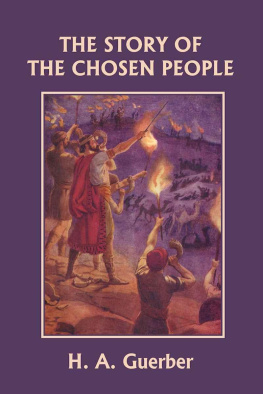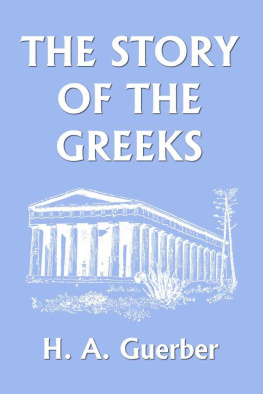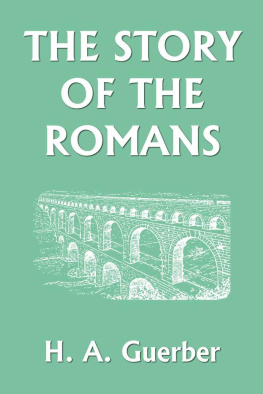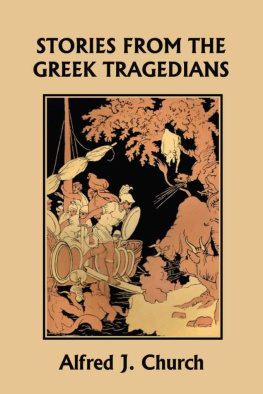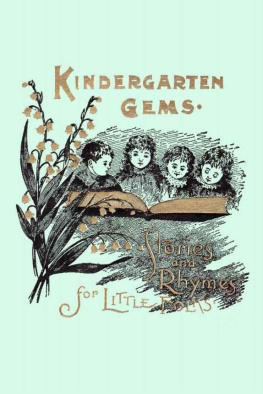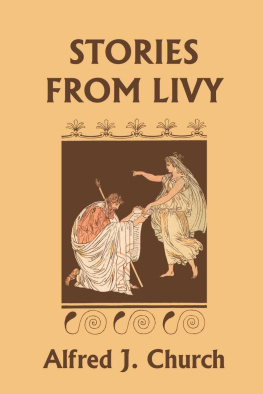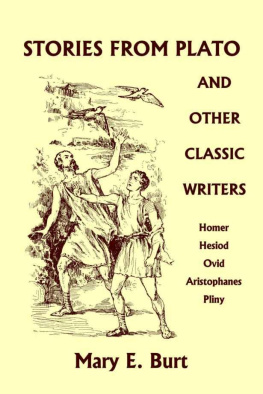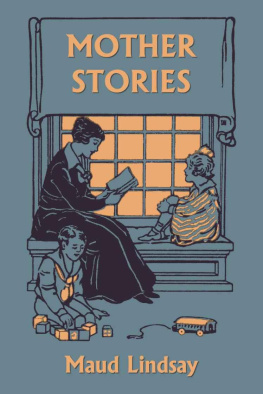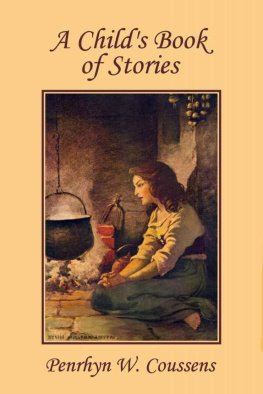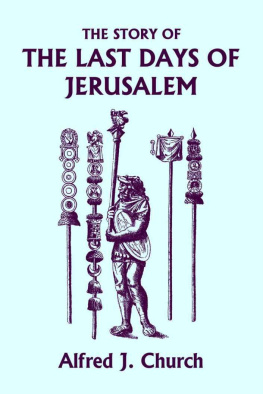The Story of the Chosen People
by
H. A. Guerber
Yesterday's Classics
Chapel Hill, North Carolina
Cover and Arrangement 2010 Yesterday's Classics, LLC
All rights reserved. No part of this book may be reproduced or retransmitted in any form or by any means without the written permission of the publisher.
This edition, first published in 2010 by Yesterday's Classics, an imprint of Yesterday's Classics, LLC, is an unabridged republication of the work originally published by American Book Company in 1896. This title is available in a print edition (ISBN 978-1-59915-331-5).
Yesterday's Classics, LLC
PO Box 3418
Chapel Hill, NC 27515
Yesterday's Classics
Yesterday's Classics republishes classic books for children from the golden age of children's literature, the era from 1880 to 1920. Many of our titles are offered in high-quality paperback editions, with text cast in modern easy-to-read type for today's readers. The illustrations from the original volumes are included except in those few cases where the quality of the original images is too low to make their reproduction feasible. Unless specified otherwise, color illustrations in the original volumes are rendered in black and white in our print editions.
Preface
In this little volume the author has tried to give a consecutive story of the Jews, or Chosen People, as objectively as the Stories of the Greeks and of the Romans, with which it forms a series. The narrative has been written in the simplest style, so as to enable even the youngest child of the third or fourth reader grade to understand it.
Not the least attempt has been made to dwell upon the strictly religious side of the subject, for, owing to the mixed population in our large cities and schools, such an attempt would be impracticable. The sole aim of this very elementary work is to familiarize children, be they of Jewish, Protestant, Roman Catholic, or Freethinker parentage, with the outline of the story contained in the Old Testament, so that they can understand the allusions which appear even in juvenile literature, and can look with intelligent appreciation upon the reproductions of works of art which are now to be found in nearly all our books and magazines.
I have found that, when told to young children, these historical narratives prove a source of much interest, and that the elementary knowledge then obtained remains so clear and vivid that even when they are grown up, and able to enter into the subject more thoroughly, the impression of the story as first heard is the one which is most permanent.
While it may seem that, with all the facilities which the country affords to rich and poor alike, such instruction in schools would be superfluous, the fact remains that, with the exception of a few well-known stories, the children have no idea of the contents of the Old Testament. This lack of general information on the subject is often a great drawback to teachers in the course of their instruction, as references are constantly made to the Bible.
Although this is a juvenile history of the Jews, it has not been written without much research; and, in order to make it as brief, comprehensive, and accurate as possible, many authorities beside the Bible, Josephus, and the Bible dictionaries, have been consulted.
It is hoped that an inkling of the story of the Jews will stimulate the children's interest, will early imbue them with a taste for history, and will give them the desire to gain further and more complete information on the subject when they grow older.
We are indebted to Merton Russell Cotes, Esq., J.P., F.R.G.S., ex-Mayor of Bournemouth, for permission to reproduce T. M. Rooke's painting of Ahab and Elijah, now in his possession, and to Messrs. Braun, Clement & Co., for the use of several of their carbons.
Contents
CHAPTER I
The Creation
T HE Bible, as you already know, is composed of two parts, called the Old and the New Testaments. Both Jews and Christians consider that the first part of this book is sacred, because it contains God's teachings as he revealed, or made them known, to man. They do not, however, agree about the second part, which is considered sacred only by Christians.
The Old Testament contains, besides God's teachings, a history of the Jews, which is so interesting and important that educated people of all countries and religions are expected to know all about it. It is this history which you are going to hear, but, of course, if you want it complete, you must read it in the Bible itself.
The very first book of the Bible is called Genesis, a word meaning "origin," because it tells us about the beginning, or origin, of the world. We are told that in the beginning there was neither land nor water, nor any living things, and that darkness rested over all.
This early stage of affairs, when the elements of all things were mixed up together, has been called Chaos (confusion); and we are told that God, the Almighty, who had no beginning or end, created, or made, the whole world out of Chaos.
The story is told very briefly indeed, and all the periods of creation are called days. Of course we now know that by days the writer of the book of Genesis did not mean twenty-four hours, as we do. The word "days" was used for an indefinite space of time; and, just as God is far more powerful than we can imagine, so his days are far longer than ours.
God's spirit moved over Chaos, and during the first day he said: "Let there be light." At these words the darkness which rested over all things vanished, and light first appeared. This light shone through the thick vapors which then surrounded the earth.
During the second day, or period, the vapors parted, and now for the first time the blue sky could mirror itself in the blue waters which covered the face of the earth. As the clouds in the sky could rain down water, the Bible says that on the second day God "divided the waters which were under the firmament [or sky] from the waters which were above the firmament."
During the third day, or period, another great change took place; for the crust of the earth, shaken by earthquakes, formed great bumps and hollows. Thus were formed mountains and valleys; and the waters, which had covered all the face of the earth, now flowed into the deep basins, where they formed lakes, seas, and oceans.
As soon as dry land appeared, God said that the earth should bring forth grass, trees, and plants of all kinds; and each one was to have seeds, so that new plants would replace the old as soon as they died. The earth had been bare and ugly when it first rose up out of the waters; but it was now covered with verdure, and became beautiful as it is to-day.
On the fourth day, God allowed the lights in the sky to be seen; and the sun, moon, and stars began to serve, as they do now, to mark the days and the nights, the seasons and the years. Darkness and light were thus clearly divided, and we are told that "God saw that it was good."
During the fifth day, or period, when the rays of the sun had strengthened the trees and plants, God created the birds and fishes, and bade them multiply and fly through the air, and fill all the waters in the seas. It is in obedience to this command that the birds and fishes lay eggs and hatch their young.
The sixth day, or period, was spent in the creation of the higher animals, and lastly of man. Now the Bible tells us that man was formed out of earth, but that he was different from all the beings which had already been created, because he was like God.
This first man bore the name of Adam. Although his body was made of dust, his life was breathed into him by God, who brought all the animals to him that he might name them, and told him that he should be master over them all.

